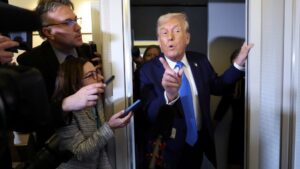The Stagflationary Outlook: Navigating Economic Uncertainty Under the Trump Administration
As we stand on the precipice of a significant economic crossroads, the U.S. economy is grappling with alarming signs of stagflation—a blend of stagnant growth and rising inflation. Recent updates from economists and insights into the administration’s policies paint a challenging picture for future economic prospects. At Extreme Investor Network, we’re committed to providing you not just with the news, but with the unique insights you need to navigate these turbulent waters.
The Anemic Growth Forecast
Recent data suggests the U.S. economy is poised for a sluggish first quarter in 2025, with an estimated GDP growth rate of just 0.3%—a stark contrast to the 2.3% growth reported at the close of 2024. This decline marks the weakest growth since the recovery from the pandemic. The core Personal Consumption Expenditures (PCE) inflation rate, a key indicator closely monitored by the Federal Reserve, is projected to hover around 2.9% for much of the year. This stagnation raises significant concerns as policies and tariffs enacted by the Trump administration contribute to a restrained economic environment.
Consumer Spending Dynamics
Delving deeper into the numbers reveals an unsettling trend in consumer behavior. The Commerce Department reported that real, inflation-adjusted consumer spending in February barely inched up by 0.1%, a slight recovery from a previous decline of 0.6% in January. Notably, Action Economics has cut its spending growth forecast for the current quarter from 4% down to just 0.2%. This steep drop underscores a broader decline in consumer and business sentiment, a critical driver of economic vitality.
Tariff Impacts and Import Dynamics
Amid these economic tribulations, an influx of imports ahead of impending tariffs has complicated GDP calculations. Higher imports subtract from GDP, temporarily skewing economic performance, though it’s worth noting that these imports can later contribute positively when measured in terms of inventory and sales. While two of the twelve economists surveyed did foresee negative growth, the majority maintain a cautious optimism for a second-quarter rebound, with forecasts suggesting GDP growth could rise to as high as 1.9%.
Rising Recession Risks
As economists analyze the data, the risk of recession looms larger. Analysts currently anticipate modest recovery, forecasting GDP growth of 1.4% in the second quarter, 1.6% in the third quarter, and 2% in the final quarter of the year. However, a meager growth rate of 0.3% raises concerns about slipping into negative territory, especially with new tariffs looming.
Mark Zandi of Moody’s Analytics provides a dire warning: “While our baseline doesn’t show a decline in real GDP, the increasing tensions of a global trade war and cuts to jobs and funding mean a recession is probable if the president doesn’t reconsider his tariff strategies by the third quarter.” Their projections estimate Q1 growth at a bare 0.4%, only slightly improving by the year’s end to 1.6%.
The Fed’s Tightrope Walk
Persistent inflation complicates the Federal Reserve’s ability to react effectively to faltering growth. The forecasted core PCE inflation rate is set to rise from 2.8% currently to 3% in the upcoming quarter, before potentially decreasing to 2.6% over the next year. Market expectations for rate cuts may be misplaced, as the Fed will likely continue grappling with the inflation issue before making any significant policy shifts.
Conclusion: Preparing for an Uncertain Future
In times like these, investors must stay informed and adaptable. At Extreme Investor Network, we emphasize the importance of developing a diversified investment strategy that can withstand market volatility. Understanding the economic landscape is crucial to making informed decisions that align with your financial goals.
As the U.S. economy faces these formidable challenges, we encourage our readers to stay engaged with our updates and analyses. Join us as we continue to navigate these uncertain waters together, transforming economic challenges into investment opportunities. Stay informed, stay strategic, and thrive in the world of investing.

